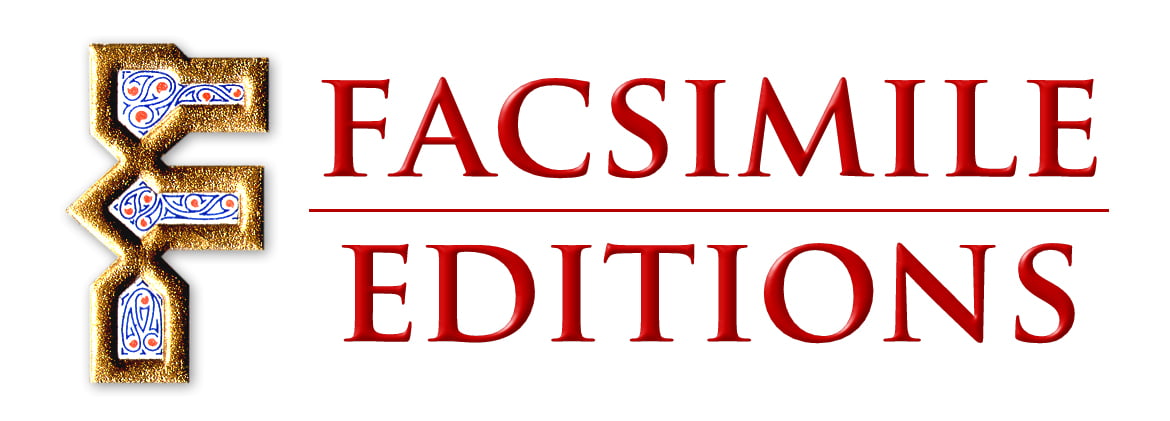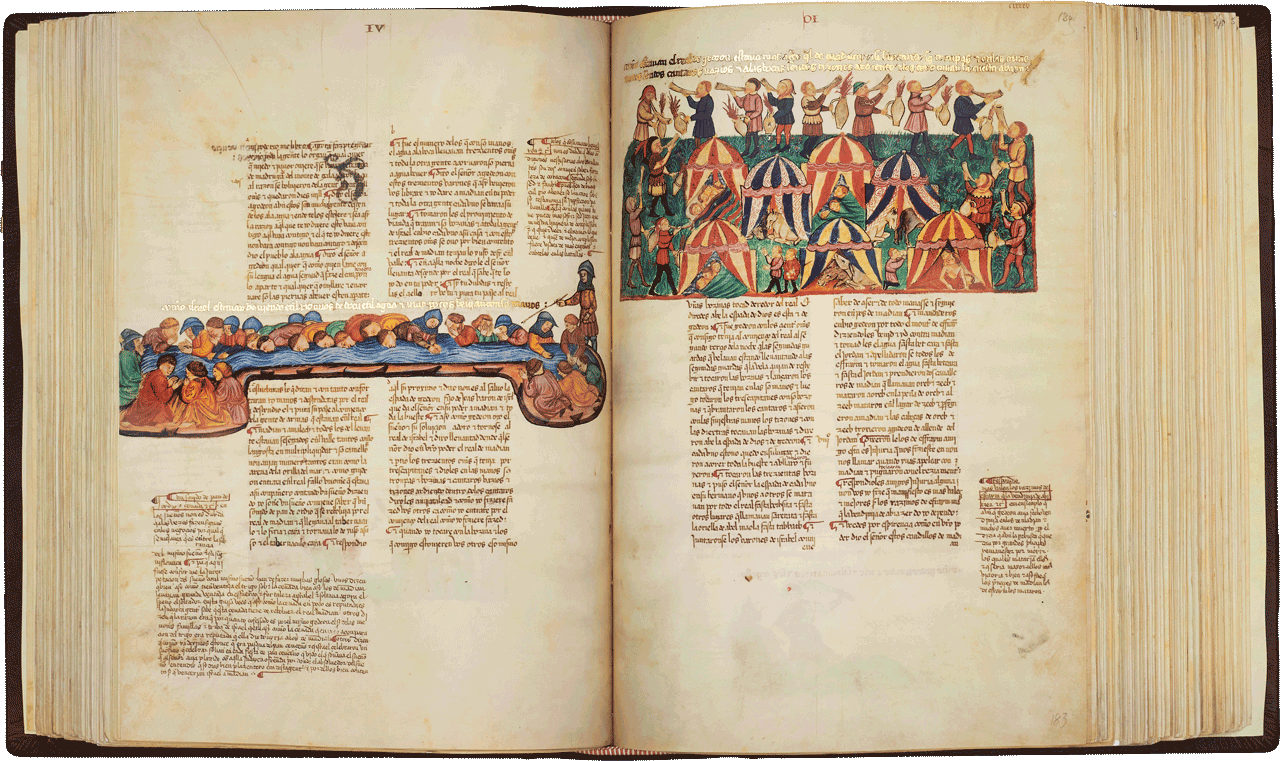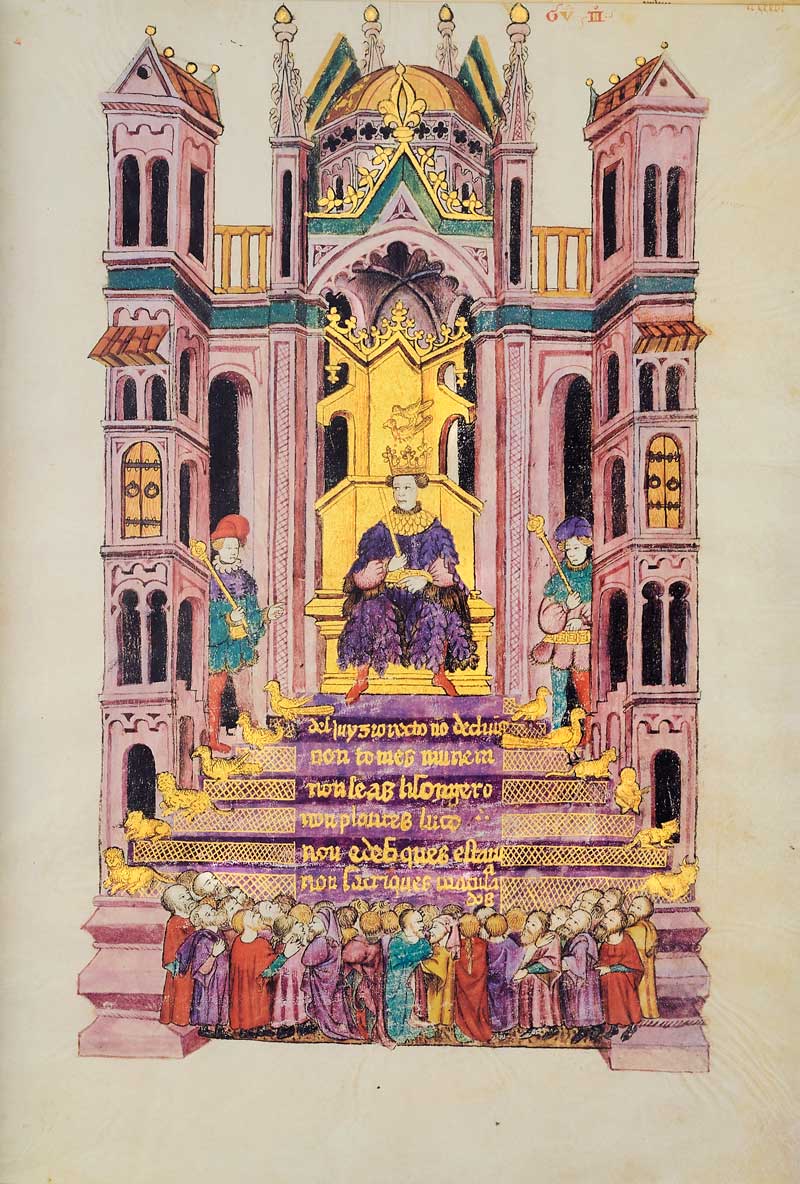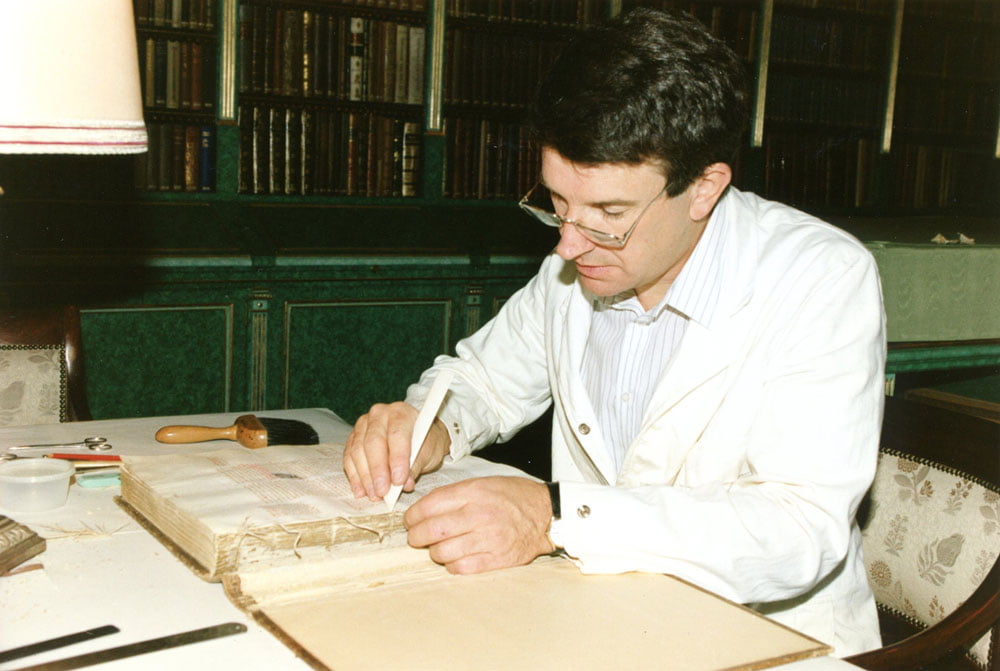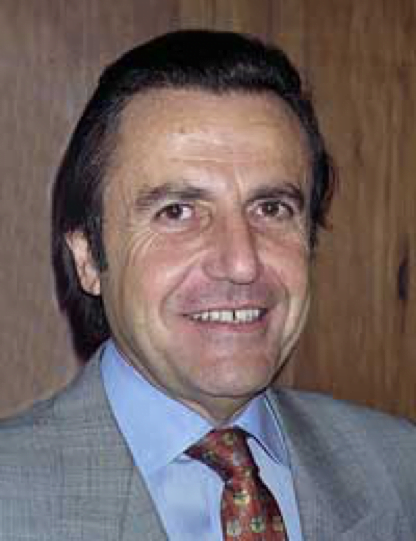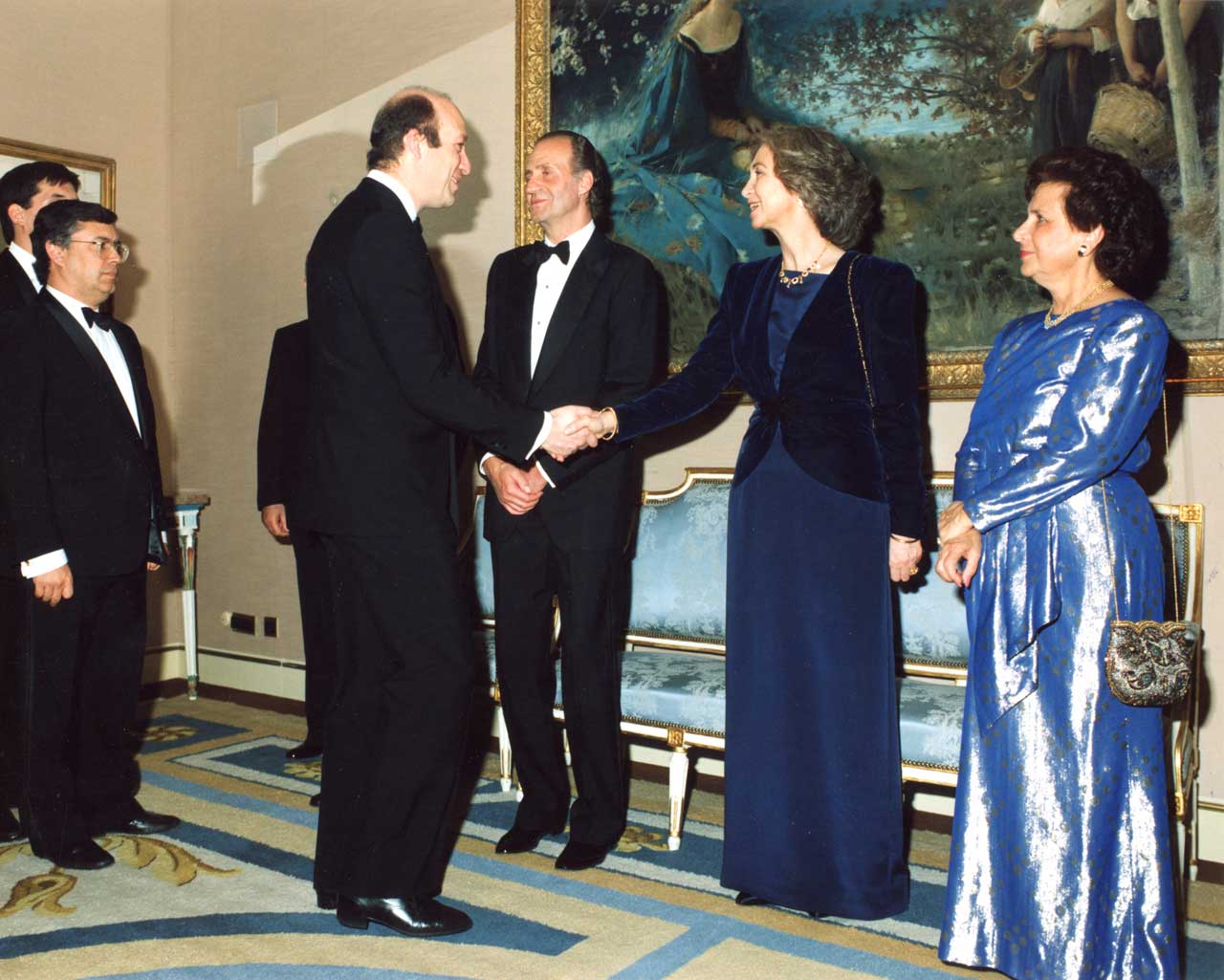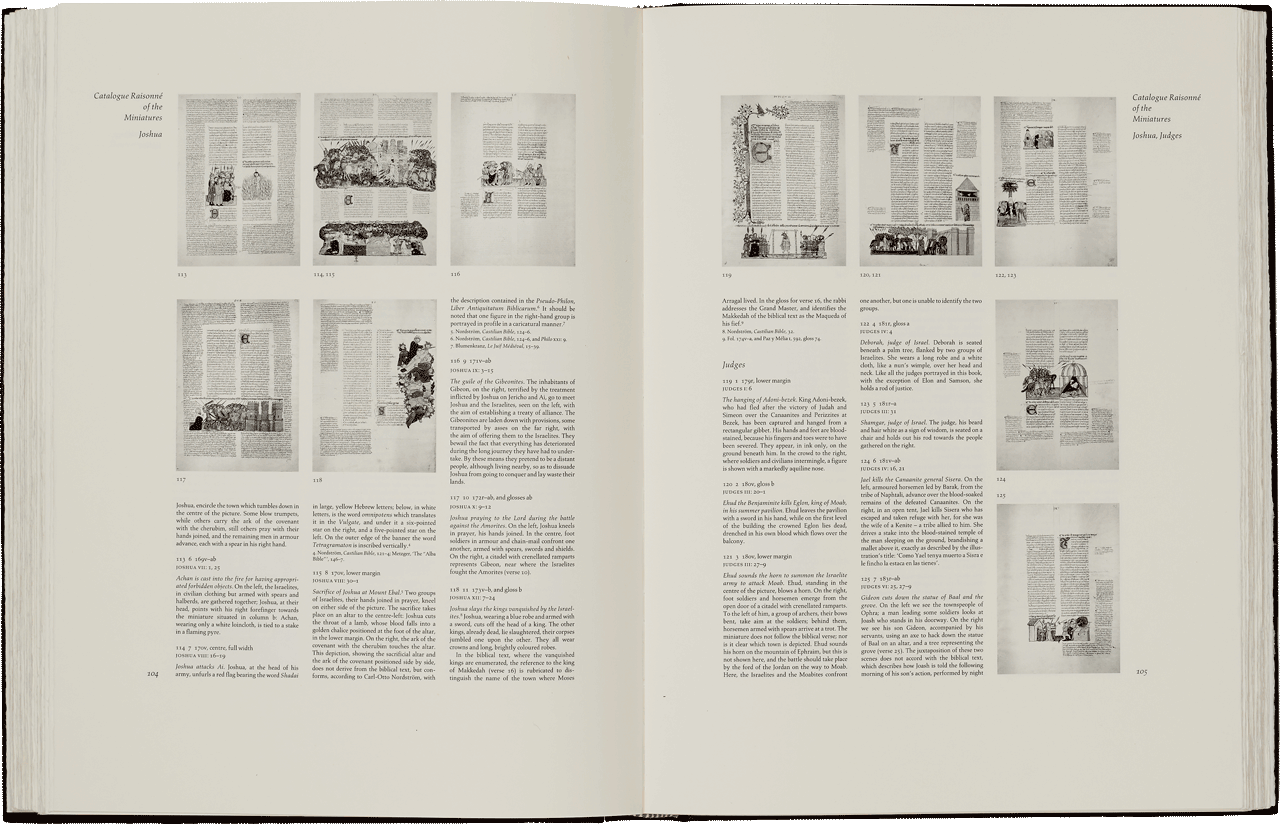The decision was itself remarkable, since Don Luis, as a high-ranking Churchman, wielded immense power in Castile. He discovered that Rabbi Moses Arragel, from the small town of Maqueda in Castile, was a person capable of such a task, and commissioned him to produce the work. The Rabbi had good reason to be reluctant – by exposing the Jewish view he feared he might fuel antagonism towards Jews, and himself in particular. He firmly refused, pointing out a Jewish prohibition against illustrated Bible manuscripts. His protest sparked off a lively correspondence with the Grand Master that has luckily survived and which he copied in the first section of the manuscript.
Pressure exerted by Don Luis, eventually forced him to relent. The monumental, illuminated manuscript known today as the Alba Bible was completed in 1430. It might well have become a symbol of hope for those Jews and Christians who, prior to the tragic end of the Jewish presence in medieval Spain, sought to improve Jewish-Christian relations.
The Alba Bible is not merely a superb example of Spanish manuscript illumination. It is all that remains of one of the last attempts by intellectual Jews and Christians to heal the rifts that finally led to the calamity of the Expulsion. The facsimile was published as a tribute to and celebration of the reconciliation and renewal of understanding taking place in our own time.
Historical background
Jewish culture penetrated deeply into Spanish life, and its influence can still be felt now, even 500 years after the Expulsion. The successful integration of the Jewish contribution was based on centuries of peaceful relations.
The eleventh century saw, in some areas, total equality of Jews and Christians. By the twelfth and thirteenth centuries, Jews were instrumental in translating Greek writers such as Plato and Aristotle from Arabic versions into Hebrew and assisting Christians in making Latin translations, effectively reviving the intellectual world of antiquity in Europe via Spain. Furthermore, Jewish works, such as Maimonides’ Guide to the Perplexed, were translated from Arabic into Hebrew and then Latin, enabling them to have an impact on Christian scholars, and influencing scholars such as Albertus Magnus and Thomas Aquinas.
Rabbis such as Moses Nachmanides and David Kimchi embellished Spanish Jewry with their wisdom and understanding, helping to engender a society that valued books not only for their contents but also for their physical beauty. Judah ibn Tibbon, writing to his son, urged him to “Make thy books thy companions. Let thy bookcases and shelves be thy gardens and thy pleasure grounds. Feed in their orchards; pluck the fruit that grows therein, gather the roses, the spices and the myrrh. If thy soul be full and weary, change from garden to garden, from furrow to furrow, from view to view…”
The Manuscript
The first twenty-five folios of the Alba Bible contain transcriptions of the detailed exchanges between Don Luis and Rabbi Moses, documenting their negotiations up to the moment when the Rabbi finally agreed to take on the task, perhaps against his better judgement. A full-page miniature depicting its completion shows Don Luis de Guzmán enthroned like King Solomon, with the Rabbi on his knees before him handing over the codex. Two monks, a Franciscan and a Dominican, were assigned to help the Rabbi in his work, doubtless in a supervisory role. A number of Christian artists were employed to illustrate the text. What emerged is no less than a masterpiece. Known as the Alba Bible, after its eventual owner, it is the most important manuscript to have survived from the reign of King John II.
The Alba Bible, with over a third of its 1,026 pages illuminated, is a powerful work of visual art. But still more significant is the vast commentary it contains. Not only is it rich in extracts from rabbinical writings such as the Targumim, Midrashim and Talmud, but also from later works such as the Zohar – the source book of Jewish mysticism. Rabbi Moses may well have given the artists detailed instructions on the illustrations, furnishing them with uniquely Jewish interpretations of biblical scenes. The resulting images are very important as cultural records, since contemporary weapons, musical instruments, furniture and costumes are all depicted.
Rabbi Moses Arragel
Against such a social background, it is remarkable that Rabbi Moses Arragel succeeded so often in presenting the Jewish view: no other extant manuscript contains so many rabbinically inspired miniatures.
For instance, Cain kills Abel by biting his neck like a serpent, exactly as is described in the Zohar. Similarly, religious objects from the Temple are depicted just as in Hebrew Bibles of the same period. We know that Rabbi Moses Arragel finished the manuscript on Friday 2 June 1430 in Maqueda, but a long time afterwards he had still not been paid for his work, and all sight of him is then lost. Most of the Jews of Maqueda converted to Christianity at the end of the fifteenth century, but the name Arragel does not appear among those who were baptized. The Alba Bible seems to be his only monument.
Public Disputation
After the manuscript left his hands in 1430, it was scrutinized by Franciscan censors in Toledo, probably until 1433, culminating in a public disputation at which theologians, knights, Jews and Moors argued their views. Following this, the manuscript disappeared until 1622, when it reached the great library of the Liria Palace, seat of the Grand Duke of Alba and Berwick, where it has been housed ever since.
Don Luis de Guzmán
Fortunately for historians, the patron of the Alba Bible, Don Luis de Guzmán, is a well-known political personage in the history of Spain. Ironically, the Bible could not be ceremoniously presented to him on its completion, since war was impending and the scene magnificently depicted in it was probably never enacted.
Few records remain from the unsettled years of John II’s reign (1406-54). Of these, the Alba Bible is the most important to have survived. It shows how, despite the prevailing hostility to the Jews it was still possible for an enlightened individual to attempt to reverse the overwhelmingly negative trend in Jewish-Christian relations.
Contents
The first 50 pages of the manuscript contain Rabbi Moshe Arragel’s ‘Memorandum’ in which he states that his intention was not to criticize or denigrate the faith and beliefs of Christians but to present, as demanded by his patron, a full rabbinical exegesis accompanied by the diverging views of Christian theologians. Don Luis insisted that Rabbi Arragel would be ‘assisted’ in his work by friars from Toledo and Salamanca. As his work was intended solely to be a compendium of exegetical materials – leaving readers free to accept or reject opinions which would not strengthen their faith – Arragel suggests that a proper title for his scholarly enterprise should be “la memoratiua” (“the Memorandum”). Arragel might have had in mind a similar technical Hebrew term used by medieval collectors of midrashim, namely yalqut (collection), as for example in the work Yalqut Shim’oni.
Arragel also compiled a Glossary for the Perplexed in which he explains several hundred words and concepts, mostly Latinisms, neologisms and technical terms including those which deal with key concepts in Christian and Jewish interpretations of the Scriptures.
The manuscript continues with the Biblical texts as follows:
Pentateuch
Genesis
Exodus
Leviticus
Numbers
Deuteronomy
Former Prophets
Joshua
Judges
I Samuel
II Samuel
I Kings
II Kings
Latter Prophets
Isaiah
Jeremiah
Ezekiel
Hosea
Joel
Amos
Obadiah
Jonah
Mica
Nahum
Habbakuk
Zephaniah
Haggai
Zechariah
Malachi
Writings
Psalms
Proverbs
Job
Daniel
Ezra
Nehemiah
I Chronicles
II Chronicles
Song of Songs
Ruth
Lamentations
Ecclesiastes
Esther
Pentateuch
Genesis
Exodus
Leviticus
Numbers
Deuteronomy
Former Prophets
Joshua
Judges
I Samuel
II Samuel
I Kings
II Kings
Latter Prophets
Isaiah
Jeremiah
Ezekiel
Hosea
Joel
Amos
Obadiah
Jonah
Mica
Nahum
Habbakuk
Zephaniah
Haggai
Zechariah
Malachi
Writings
Psalms
Proverbs
Job
Daniel
Ezra
Nehemiah
I Chronicles
II Chronicles
Song of Songs
Ruth
Lamentations
Ecclesiastes
Esther
Commissioning the Facsimile
In 1992, His Majesty King Juan Carlos of Spain publicly retracted the 500-year-old order that signalled the expulsion of the Jews from Spain. It had never formally been repealed. Jews were officially welcomed back to the country from which their ancestors were driven and old communities re-established in a sincere bid to undo the evil committed by the Inquisition centuries ago.
This extraordinary and unprecedented turn of fate was commemorated by the publication of a magnificent facsimile edition of this unique manuscript. After the Duke of Alba agreed to allow a facsimile to be made of his masterpiece, the publishers of the Alba Bible facsimile received the following commission from its new patron Mauricio Hatchwell Toledano: “I want the most beautiful facsimile ever produced, no more, no less…“
Just as the manuscript itself was ordered by a powerful leader, so the facsimile was the brainchild of Mauricio Hatchwell Toledano the moving force behind the International Jewish Committee Sepharad ’92, and the founder of the Fundación Amigos de Sefarad of Spain. He decided that the Alba Bible would be a living testament to the spirit of 1992, reviving and fulfilling the long-forgotten hopes of those who had laboured over it five centuries before.
Commissioning The Facsimile
In 1992, His Majesty King Juan Carlos of Spain publicly retracted the 500-year-old order that signalled the expulsion of the Jews from Spain. It had never formally been repealed. Jews were officially welcomed back to the country from which their ancestors were driven and old communities re-established in a sincere bid to undo the evil committed by the Inquisition centuries ago.
This extraordinary and unprecedented turn of fate was commemorated by the publication of a magnificent facsimile edition of this unique manuscript. After the Duke of Alba agreed to allow a facsimile to be made of his masterpiece, the publishers of the Alba Bible facsimile received the following commission from its new patron Mauricio Hatchwell Toledano: “I want the most beautiful facsimile ever produced, no more, no less…“
Just as the manuscript itself was ordered by a powerful leader, so the facsimile was the brainchild of Mauricio Hatchwell Toledano the moving force behind the International Jewish Committee Sepharad ’92, and the founder of the Fundación Amigos de Sefarad of Spain. He decided that the Alba Bible would be a living testament to the spirit of 1992, reviving and fulfilling the long-forgotten hopes of those who had laboured over it five centuries before.
James Brockman, renowned bookbinder, prepares the manuscript prior to disbinding for photography.
Israeli photographer, David Harris, in his ‘studio’ in the basement of the Palacio de Liria, Madrid. He stands behind a large-format Sinar monorail camera and umbrella flash heads.
James Brockman cuts the sewing so that the leaves can be separated and opened flat for photography.
After photography the images are processed in Madrid, Spain, and inspected in the laboratory before handing over to Facsimile Editions for colour separation in Milan, Italy.
Production of the facsimile
Unrelenting in his quest for the finest quality, he commissioned Facsimile Editions, to produce the facsimile to hitherto unsurpassed standards, combining the finest materials and the very best craftsmanship.
Its paper, formulated to reproduce the exact feel and opacity of the original parchment, was specially milled in Italy. The pages of the manuscript were disbound at the Palacio de Liria in Madrid by James Brockman, the world-renowned bookbinder from Oxford so that the folios could be laid flat for photography. Israeli photographer David Harris brought equipment from London and Jerusalem to Madrid in order to photograph the manuscript and used large-format film specially manufactured in a single batch and processed at the same laboratory in order to ensure a constant colour balance. Over the following twelve months, colour separators from Milan joined Linda Falter and the printer for regular meetings at the Liria Palace in Madrid, where page proofs were compared with the original to achieve the finest possible colour-match.
The smallest details were examined and are all reproduced in the facsimile. For the entire period of production Linda and Michael Falter stayed in Milan constantly supervising their team of craftsmen.
The Binding
The original’s binding no longer exists. A blind-tooled Mudéjar binding now in Toledo Cathedral and produced in the same era and geographical area as the manuscript, was chosen as a model for both the facsimile and a new binding for the original manuscript. From images of the Mudéjar binding, London artist and graphic designer Goldie Grahame painstakingly recreated the intricate designs from which the binding’s tooling-dies were then created. Working from his atelier outside Milan, Angelo Recalcati and his team hand-sewed the quires and blind-tooled the large morocco goatskins covering the facimile’s wooden boards before placing it, with its extensive commentary volume, into the custom designed library case.
Mauricio Hatchwell Toledano
Mauricio Hatchwell Toledano, Chairman of Sepharad ’92, had the vision to persuade the Duke of Alba to allow the production of the facsimile of the Alba Bible as a physical reminder in perpetuity of the renunciation of the Expulsion.
Mauricio Hatchwell explains the siginificance of the Alba Bible (Spanish)
Read Mauricio Hatchwell's message
Message from the Chairman of Sepharad ’92
1492 represents a gigantic step in the history of mankind due to the discovery of the New World. It is also the date of an event that deeply and forever marked the destiny of Spain, since at that date it took the decision to expel its Jews, which, as Professor John Eliott said, weakened the foundations of the Spanish Monarchy at the very beginning of its imperial journey.
In fact, for Spanish Jews Sefarad was not a country of exile but rather a homeland. Very rarely, if at all, did a Jewish community reach such splendour, such glory and for such a long period, almost 500 years.
The school of translators of Toledo, cradle of the modern Spanish language, is an outstanding example of this Golden Age, a fortunate period in which the faithful researchers of the three monotheistic religions, children of the same God, worked in harmony to provide the world, in a unique and truly exceptional case, with some more light and more hope in a frame of TOLERANCE.
1992 marked the fifth centenary of the sudden interruption of an age that still today holds us in awe. To commemorate this spiritual odyssey, which belongs to the Jewish patrimony, Sephardim and Ashkenazim together constituted the International Jewish Committee Sepharad ’92. Its members were Jews and non-Jews and included the Foundation Friends of Sefarad, Jewish communities throughout the world, and the main North American and European Jewish Organizations. The Honorary Chairman was Nobel Laureate Elie Wiesel.
We, the International Jewish Committee Sepharad ’92 wish to give a balanced version of history, in particular of our own history, in the dawn of the 21st century. 1992 must represent not only the legitimate reminder of the tragedy we went through, but also the occasion to acknowledge and help the entire world:
- to know and to learn the history of our ancestors in Spain, who were not only massacred by intolerance but buried a second time by the forgetfulness of history
- to remind the world, Jews and non-Jews, about what is unfortunately taken for granted, but which has to be emphasized and repeated time and time again: the Jewish contribution, both Sephardi and Ashkenazi, to Western civilization. In addition, as the People of the Book, Jews have in the last generation, with the resurgence of the State of Israel, proved their ability in agriculture, high technology and the art of military survival.
- to acknowledge the message of the previous centuries: that TOLERANCE is a desirable form of civilization for humanity and a formula for progress in the future of nations.
“Forgetfulness leads to exile while remembrance is the secret of redemption”
Mauricio Hatchwell Toledano
Mauricio Hatchwell Toledano
Mauricio Hatchwell Toledano, Chairman of Sepharad ’92, had the vision to persuade the Duke of Alba to allow the production of the facsimile of the Alba Bible as a physical reminder in perpetuity of the renunciation of the Expulsion.
Read Mauricio Hatchwell's message
Message from the Chairman of Sepharad ’92
1492 represents a gigantic step in the history of mankind due to the discovery of the New World. It is also the date of an event that deeply and forever marked the destiny of Spain, since at that date it took the decision to expel its Jews, which, as Professor John Eliott said, weakened the foundations of the Spanish Monarchy at the very beginning of its imperial journey.
In fact, for Spanish Jews Sefarad was not a country of exile but rather a homeland. Very rarely, if at all, did a Jewish community reach such splendour, such glory and for such a long period, almost 500 years.
The school of translators of Toledo, cradle of the modern Spanish language, is an outstanding example of this Golden Age, a fortunate period in which the faithful researchers of the three monotheistic religions, children of the same God, worked in harmony to provide the world, in a unique and truly exceptional case, with some more light and more hope in a frame of TOLERANCE.
1992 marked the fifth centenary of the sudden interruption of an age that still today holds us in awe. To commemorate this spiritual odyssey, which belongs to the Jewish patrimony, Sephardim and Ashkenazim together constituted the International Jewish Committee Sepharad ’92. Its members were Jews and non-Jews and included the Foundation Friends of Sefarad, Jewish communities throughout the world, and the main North American and European Jewish Organizations. The Honorary Chairman was Nobel Laureate Elie Wiesel.
We, the International Jewish Committee Sepharad ’92 wish to give a balanced version of history, in particular of our own history, in the dawn of the 21st century. 1992 must represent not only the legitimate reminder of the tragedy we went through, but also the occasion to acknowledge and help the entire world:
- to know and to learn the history of our ancestors in Spain, who were not only massacred by intolerance but buried a second time by the forgetfulness of history
- to remind the world, Jews and non-Jews, about what is unfortunately taken for granted, but which has to be emphasized and repeated time and time again: the Jewish contribution, both Sephardi and Ashkenazi, to Western civilization. In addition, as the People of the Book, Jews have in the last generation, with the resurgence of the State of Israel, proved their ability in agriculture, high technology and the art of military survival.
- to acknowledge the message of the previous centuries: that TOLERANCE is a desirable form of civilization for humanity and a formula for progress in the future of nations.
“Forgetfulness leads to exile while remembrance is the secret of redemption”
Mauricio Hatchwell Toledano
Mauricio Hatchwell explains the siginificance of the Alba Bible (Spanish)
Presentation at the Pardo Palace, Madrid
The culmination of this year-long publishing project took place on 31 March 1992 at the Pardo Palace in Madrid, where Mauricio Hatchwell Toledano presented His Majesty King Juan Carlos of Spain and H.E. President Herzog of Israel each with a copy of the Alba Bible facsimile. On the same occasion the King revoked the order of the Expulsion of the Jews from Spain, and formally welcomed their descendants – and all Jews – back to Spain.
Their Majesties King Juan Carlos I and Queen Sofia welcome Michael Falter to the Pardo Palace in Madrid.
Mauricio Hatchwell Toledano presents the first two copies of the Alba Bible to King Juan Carlos I of Spain and President Chaim Herzog of Israel.
Linda Falter discusses the production of the facsimile with Their Majesties King Juan Carlos I and Queen Sofia.
Commentary Volume
Leading scholars were commissioned to research and describe in detail the source and content of the manuscript’s text and iconography. The results of their work appear in an elegant, heavily illustrated commentary volume designed by the eminent Gerald Cinamon, one of the most skilled book designers and typographers of his generation, assisted by Anthony Kitzinger. Chapter openings were designed and hand drawn by master calligrapher Satwinder Sehmi. The commentary volume was edited by Jeremy Schonfield.
Shlomo Ben-Ami
Former Israeli diplomat, politician and historian, describes Sephardi Jewry’s contribution to Spanish civilization.
Sonia Fellous-Rozenblat
Of the C.N.R.S., Professor of Jewish Art at the Institut National des Langues et Civilisations Orientales, Paris, examines in detail the background to the commissioning of the manuscript and describes the symbolism of its magnificent iconography. Sonia Fellous has since published a beautifully illustrated description of the manuscript’s iconography: Histoire de la Bible de Moïse Arragel (Somogy éditions d’art, France ISBN 2-85056-516-4)
Adriaan Keller
Doctoral researcher at Leiden University, investigates the codicology and palaeography of the manuscript.
Moshe Lazar
Professor of Comparative Literature at U.C.L.A., studies the Bible translation and the commentary appearing in the manuscript.
Angus McKay
Professor of Medieval Spanish History at the University of Edinburgh, discusses Jewish-Christian relations in Spain at the period of the Alba Bible.
The commentary volume is bound in a morocco binding to complement that of the facsimile.
Specification
CODICOLOGY
Size 405 x 295 x 110mm (16″ x 11.5″ x 4.5″) approximately.
Pages vary slightly in size. 1,026 pages 513 folios numbered 1-513
Inquisitor’s Licence.
Commentary volume page size 412 x 309mm (16.2″ x 12.2″) approximately.
PAPER
The uncoated, neutral pH, 160 gsm paper was developed and milled exclusively for this facsimile by one of Italy’s finest specialist paper mills.
The commentary volume is printed on specially milled 190 gsm Magnani mould-made, deckle-edged, water-marked paper.
COLOUR SEPARATION & PROOFING
Colour separators combined laser scanning with painstakingly precise hand-work in order to prepare the colour separations necessary for the first proofs. These were compared with the original manuscript in Madrid and, where necessary, up to four additional sets of proofs were made to ensure accuracy to the original.
PRINTING
The facsimile is printed by offset lithography in up to twelve colours. Every single sheet was printed under the close and critical supervision of the publishers, who stayed by the press in Italy for the entire duration of the printing.
GOLD & SILVER
The three different types of gold and silver found in the manuscript are all faithfully copied in the facsimile.
Raised gold and silver is reproduced by a unique process developed specially by the publishers for their facsimiles. Craftsmen apply the metal leaf individually to each page, using a ‘building-up’ process to replcate the raised in the original.
Flat gold and silver are applied using wafer-thin leaves of metal and, where necessary, overprinted to give the wide range of colours and textures of gold found in the original manuscript. Gold powder is applied to all those illuminations containing brush-applied gold in the original.
Since much of the silver in the manuscript has tarnished, oxidized silver was reproduced, both flat and raised.
HOLES
The pages of the manuscript contain many holes, either occurring naturally in the skins used by the scribe or made by bookworm over the centuries. These are reproduced in the facsimile.
CUTTING
Each page is trimmed to the size and shape of the original, including irregularities, and then gilded at the edges.
BINDING
As the manuscript’s original binding no longer exists, a morocco goatskin Mudéjar-style binding of the period on wooden boards, blind-tooled with interlacing geometric designs and finished with solid brass clasps on leather thongs, was faithfully copied. The original is located in the Cathedral of Toledo. The quires are hand-sewn scrupulously observing and retaining the quire formation of the original Alba Bible.
EDITION
Strictly limited to 500 copies
150 Founder’s Copies in special presentation cases with full-leather rounded spines, numbered 1 to 150
300 copies in presentation cases with square spines, numbered 151 to 450
50 Ad Personam copies, numbered I to L
DESTRUCTION OF THE PRINTING PLATES
On completion of the 500th copy, the printing plates were destroyed in order to preserve the edition’s significant investment value.
Sold out very shortly after publication, the facsimile edition is now out of print.
However, from time to time we are approached by individuals wishing to dispose of their copy. To obtain one of these copies (or to ask us to place it for you) please contact us so that we can let you know as soon as a copy becomes available.
